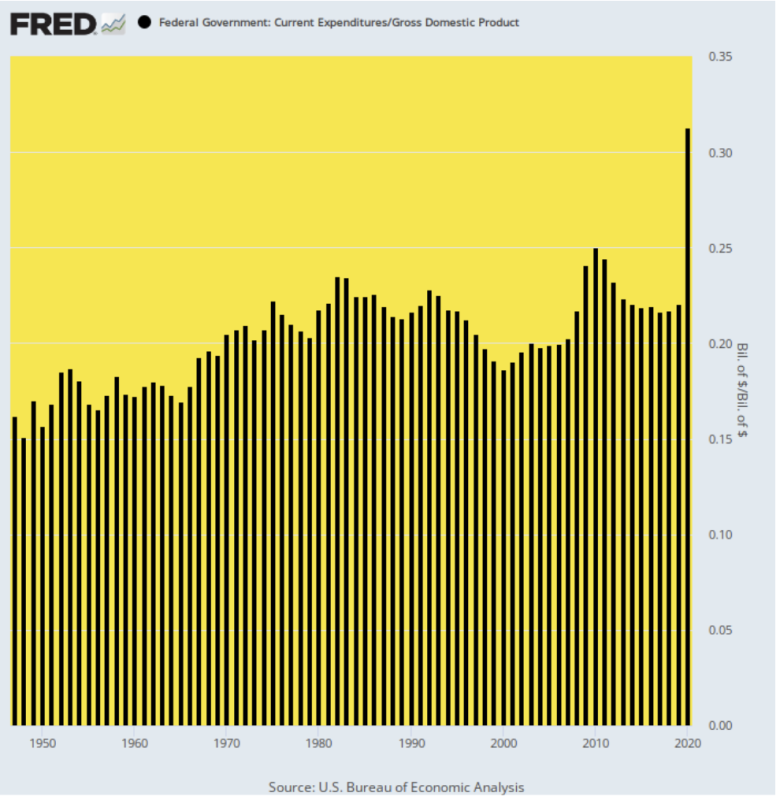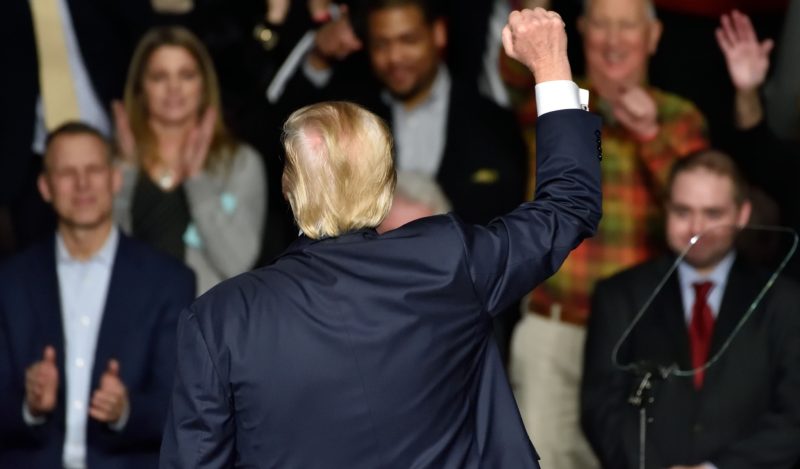This evocative line in the opening scenes of Gladiator, when the German barbarians are about to be annihilated yet again by the Roman legions, begs to be endlessly adapted:
People should know when they are conquered. ~ Quintus
For example, the US military’s recent bombing raid on Baghdad made you wonder. Are the citizens of the once and former site of Washington’s “shock and awe” campaign to rid them of Saddam Hussein’s evildoings ungrateful or what?
People should know when they have been liberated!
The same thing happened this week in conjunction with the publication of our new book, Trump’s War on Capitalism. One hour before our scheduled interview time we were “cancelled” by a nationally syndicated conservative radio and TV host, who, upon belatedly reading the first chapter, concluded the book is way too anti-Trump.
Well……..people should know when they are being conned!
Yes, the conservative agenda is not just about taming the Leviathan on the Potomac, but surely that’s the heart of it. All the consequent anti-freedom evils of Big Government ultimately feast upon an open-ended call on the peoples’ money and property.
So how can “conservatives” possibly explain the graph below? To wit, the dramatically evident fact that the Donald waded into Washington’s overflowing swamp in 2017 and proceeded to fill it deeper than ever before.
In fact, whether Washington taxes or borrows its fiscal wherewithal, the ultimate metric on the size and intrusiveness of government is the spending share of GDP. That telltale ratio had been steadily marching uphill during the entire post-war period, but it literally went into rocket-ship mode during the Donald’s disastrous last year in office.
The Federal spending figure for 2020 was 31.3% of GDP. Moreover, the history of the ups and downs of that ratio during the decades preceding Trump’s spending abomination tells you all you need to know about the staggering extent of his fiscal perfidy.
Thus, when Give ’em Hell Harry Truman left office at the end of the Korean War, the Federal spending share of GDP was 18.5%, or more than double the Federal claim on national income that had prevailed during the prosperous decades before the New Deal.
Then the great Dwight Eisenhower spent the next eight years rolling back the military juggernaut that had been revived to liberate the no-count peninsula of Korea from the commies, as well as trimming some fat from the New Deal spending inheritance. After insisting that there would be no cuts in the high wartime tax rates until the budget was balanced, Ike did get the government’s spending take from the peoples’ resources down to 17.2% of GDP in 1960. That turned out to be an all-time post-1950 low, and it was accomplished by America’s greatest wartime general, who knew where the pork and waste was buried in the defense budget and cut it by nearly one-third in real terms during his tenure.
Soon thereafter LBJ was busy bringing the blessings of the Great Society to both America and Southeast Asia, causing the spending share to sharply rise to 19.6% in 1968.
Back then the GOP was still huffing and puffing about “runaway spending” but doing virtually nothing at all about it. When the Nixon-Ford Administration vacated the White House after 1976 the spending share of GDP had jumped further to a peacetime record of 21.5%.
Jimmy Carter talked a lot during the next four years about controlling inflation and liberating America from the alleged thrall of Persian Gulf oil imports, but essentially ran in place when it came to the emerging Leviathan on the Potomac. The Federal spending share in 1980 was up a tad to 21.8% of GDP, which was about where Carter started.
Your editor became the nation’s fiscal windmill tilter-in-chief thereafter, and we did give it a run with Ronald Reagan’s full blessing and backing. But the Gipper was actually a half-assed fiscal conservative: He was all for retrenchment in Washington, except on the Pentagon side of the Potomac!
So by 1988 “out of control” government spending highlighted in Ronald Reagan’s 1980 campaign had been reduced by, well, 40 basis points of GDP, to 21.4%.
Then came two big deficit reduction bills under Bush the Elder and Bill Clinton, respectively, in the early 1990s. Both were pretty decent Capitol Hill budget deals that traded modest additional revenues for major spending cuts, and happened before Newt Gingrich and Dick Cheney had later put an anathema on tax increases of any size, for any reason, ever.
These deficit reduction deals were followed by a mini peace dividend in the form of initially stagnant post-Cold War defense spending. Accordingly, by the time Clinton shuffled out of the Oval Office—blue dress and all–in 2000, the Federal spending share had been, miraculously, rolled back to 18.6% of GDP, or where Harry Truman had left it a half-century earlier.


The reason for those gains, however, was that the GOP leaders in the 1990s still pretty much believed that deficits matter and, also, the Washington neocons had not yet taken full control of the Uniparty. So after the shock of 9/11 it was suddenly all over except the shouting.
Thereupon Bush the Younger launched the Forever Wars and major new Medicare entitlements, among others. So the Federal spending ratio resumed its upward march with a vengeance. By 2008, the ratio was back to 21.9%, thereby topping even Jimmy Carter’s prior record level.
Coming into the White House at the bottom of the deepest recession since the 1930s, the Obama Democrats moved with alacrity to prime the Keynesian pump with their shovel-ready boondoggles of February 2009. These measures did precious little for what by then was a speculation-riven financial system and debt-entombed Main Street economy, but they did temporarily push the Federal spending ratio upward to a new record at 24.9% of GDP.
As misguided as their economic philosophy was overall, however, the Obama Keynesians did have a modicum of consistency. They permitted Federal spending to fall in relative terms as the US economy slowly recovered from the housing collapse and the Wall Street meltdown of 2008-2009. By 2016, the Federal spending ratio had returned to 21.9% of GDP, marking a peak level line of sight going back 36 years to Carter’s last budget.
Needless to say, 2017 marked the most propitious circumstance in decades for the GOP to implement the fiscal stringencies it was always speechifying about. The economy was in full mid-cycle recovery, and without any need at all–even by Keynesian lights—for fiscal stimulus or a deficit-fueled boost to the Main Street economy. And after 16 years of fiscal insouciance under Bush the Younger and Obama, the Federal budget was flush with fat, waste, and myriad unnecessary Federal missions.
But the Donald had no affinity whatsoever for the traditional GOP gospel of fiscal austerity. On the defense side, he fancied himself the greatest negotiator in world history, and therefore sought a really big stick in terms of military might. Accordingly, during his first three years the defense budget—which was already obese in 2016—rose from $593 billion to $686 billion by 2019.
As for domestic spending, he basically had bigger fish to fry. Nondefense outlays rose from $3.3 trillion in 2016 to $3.8 trillion by 2019. The Donald thereby made very clear that building the wall on the border and pursuing the culture wars was a lot more important than actually doing the GOP’s job, which is to chisel away at Leviathan at every opportunity, but especially during intervals of brighter macroeconomic performance.
Accordingly, the fiscal sweet spot of 2017-2019 passed by without even a nod toward spending retrenchment by the Trump Administration. After all of the existing entitlements, new programs, standing appropriations and emergency spending measures were totted up, total Federal outlays rose from $4.175 trillion in 2016 to $4.792 trillion in 2020. As a matter of relative fiscal magnitudes, that $617 billion gain in the Donald’s first three budgets was equal to 91% of the entire annual budget during Ronald Reagan’s first year in office.
It also amounted to a 15% spending gain, which matched the rise of nominal GDP during the three-year period. So by the math of it, the peak “big spender” ratio left behind in 2016 by the Obama Administration was still 21.9% of GDP after three years of the Donald talking incessantly about how he was draining the Swamp.
He drained nothing, of course, when he had the chance. And then came the deluge—the virtual coup d’état by Dr. Fauci and his coterie of public health tyrants. As the Donald stood around like a deer-in-the-headlights as they locked down the economy, he then sought to rescue his election year bacon by cranking-up a tsunami of offsetting stimmies that blew the Federal budget $1.1 trillion higher during the single year of 2020.
As the US economy, in turn, buckled under the madness of the Lockdowns, the spending ratio literally shot the moon. The Donald advocated for and signed the $2.2 trillion CARES Act after just 11 days of superficial Congressional consideration and endorsed every measure of additional economic and fiscal mayhem that transpired later in the disastrous year of 2020.
Consequently, the fiscal abomination of 2020 is writ large in the spending ratio depicted in the chart above. It hit 44.3% of GDP in Q2 2020 and averaged 31.3% of GDP for the full year.
Needless to say, there was nothing close to this spending bonanza on the revenue side of the ledger, meaning that budget deficits literally went into orbit during the Donald’s four years.
In fact, the Obama folks had followed the Keynesian rules and brought the deficit down in cyclical fashion from a peak of $1.4 trillion in 2009 to $585 billion by 2016—only to have the newly installed King of Debt in the Oval Office march the deficit back uphill, all the while proclaiming the Greatest Economy Ever. By 2019 the deficit was back to nearly $1 trillion annually.
Thereafter, of course, fiscal hell broke loose in 2020, with the deficit rising to an incredible $3.1 trillion and nearly 15% of GDP. In all, the Federal deficit averaged 9.0% of GDP during the Donald’s four years—a figure nearly 4X the post-war average of all presidents, Dems and Republicans alike.
In the final scorekeeping, the Donald’s fiscal catastrophe cannot be gainsaid. That is, at the top of the business cycle when deficits were supposed to be coming down sharply or eliminated entirely, he added nearly $8 trillion to the public debt in four short years.
As it happened the first $8 trillion of the US public debt was not reached until 2005, and it took 216 years and 43 presidents to get there. So try that on for size!
So, yes, the MAGA hats have been conned big time, indeed. Trump has proven himself to be the epitome of a Caesarian Big Government statist. And yet the ostensible opponents of Big Government and all its baleful works do not even want to discuss the elephant in the room.
Reprinted from David Stockman’s private service.
Join the conversation:


Published under a Creative Commons Attribution 4.0 International License
For reprints, please set the canonical link back to the original Brownstone Institute Article and Author.









